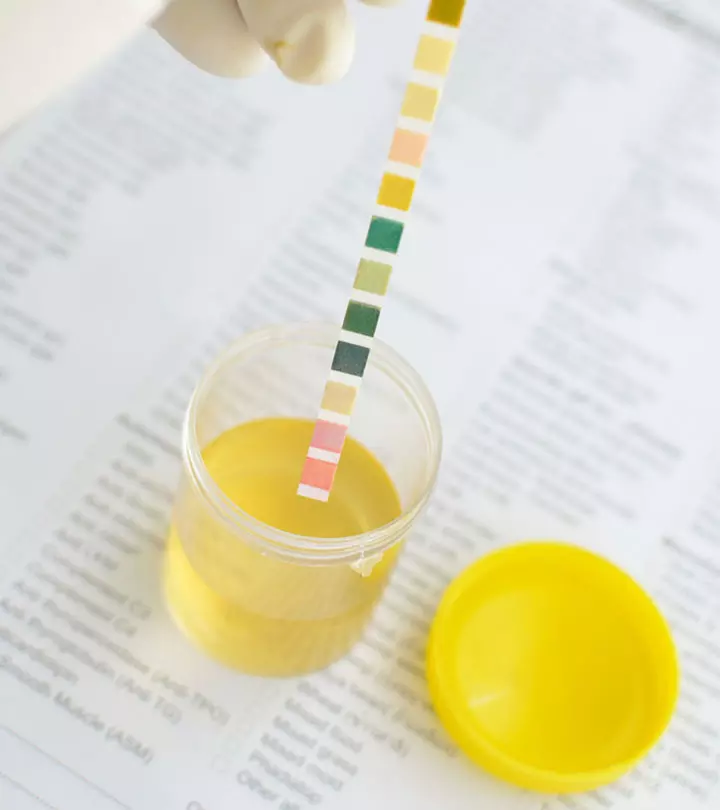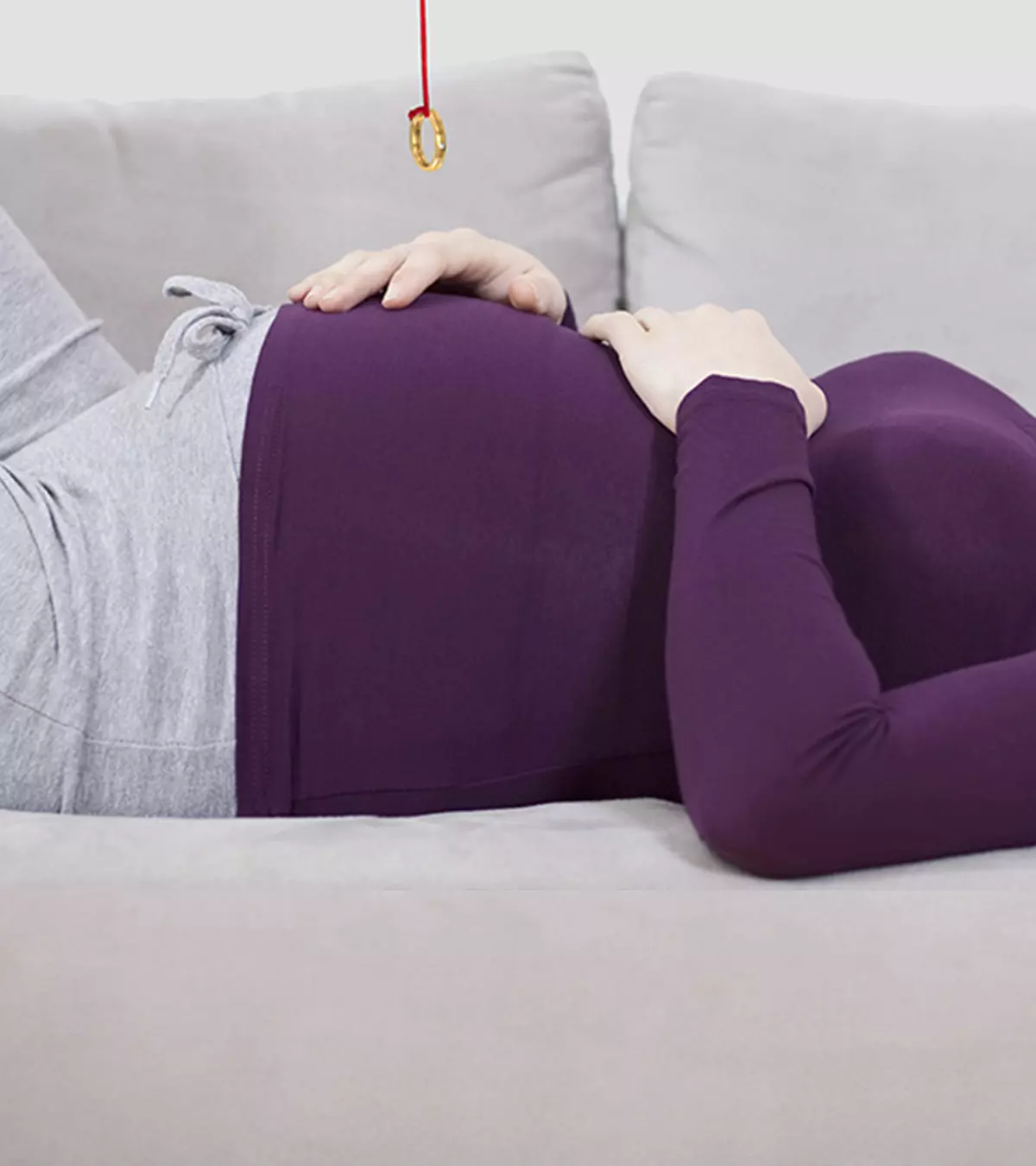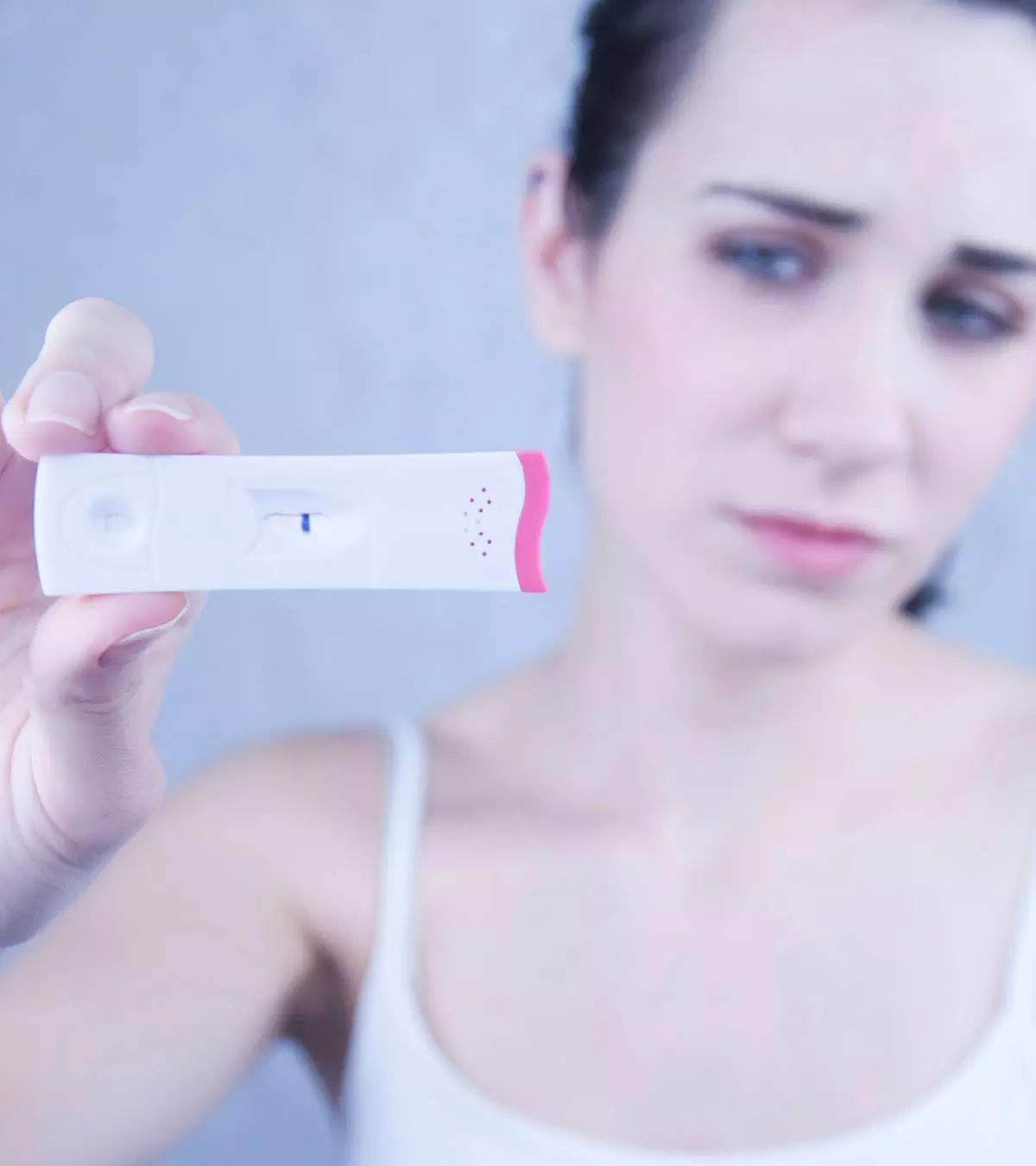
Image: Midjourney/ MomJunction Design Team
Guessing an unborn baby’s gender can be fun and interesting. Perhaps that’s why there are several old wives’ tales on this topic. One such myth calls for checking for certain symptoms that are considered the symptoms of a baby girl during pregnancy.

Though these signs or symptoms may have predicted the baby’s gender correctly for some mothers, it is usually due to luck and has no scientific backing. Hence, detecting a baby’s gender by mere signs and symptoms is impossible. Instead, getting an ultrasound at 20 weeks can help (1). Greg J. Marchand, MD, FACS, FACOG, program director at Steward Health, Providence, Rhode Island, says, “You cannot determine the sex without blood testing, ultrasound, MRIiA diagnostic device that uses computer-generated radio waves and a magnetic field to create detailed images of tissues and organs in the body , or some form of invasive sampling such as amniocentesisiPregnancy test to check for genetic or chromosomal abnormalities in the baby or CVS (Chorionic Villus Sampling)iA prenatal diagnostic test to determine chromosomal or genetic disorders .”
However, if you’re looking for a fun way to pass the time, keep reading for some interesting beliefs about baby girl symptoms. Want to check if these beliefs prove true in your case?
Key Pointers
- Although there are different myths about predicting the sex of babies, none of them is scientifically proven.
- Some symptoms that are thought to indicate a baby girl include carrying the baby low, having clear and smooth skin, and experiencing less morning sickness.
- However, these symptoms are not reliable indicators of the baby’s gender and can vary from woman to woman.
- Ultrasound and genetic testing are foolproof ways to identify the gender of the baby.
- Remember, a healthy pregnancy should be the priority not the gender of the baby.
Signs You Are Having A Baby Girl – Are They True?
Obstetrician and gynecologist Dr. Swati Chitnis opines, “The baby’s gender is determined by the genetic composition of the sperm. This is a natural process that cannot be controlled, meaning the baby’s gender cannot be selected or reliably predicted. Additionally, physical signs and symptoms depend on multiple factors, and no studies have shown they can accurately indicate gender.”
Here are some signs people use to guess if the unborn baby is a girl. We’ve tried to cover the beliefs across the globe, from the Americas and Europe to Asia. Some date back to ancient Egypt as well. However, none of these have scientific backing, as these signs may also be true in baby boys.
Consult your healthcare professional for personalized guidance on pregnancy-related changes, symptoms, concerns, and decisions. They also accurately predict your baby’s gender through scientific methods. However, if fetal sex determination is illegal in your country, you may have to wait until birth.
1. Fetal heart rate is high
An elevated heart rate, above 140 -160 beats per minute, is one of the signs you are pregnant with a girl.
Scientific studies state that there is no relation between the heart rate and the baby’s sex. The normal fetal heartbeat ranges between 120 and 160 bpm, and might usually go lower before birth (2). Also, there is no difference between the heart rates of male and female babies in the first trimester (3).
2. Carrying high
Another age-old belief says that if you appear to carry your baby higher, it indicates that you are pregnant with a baby girl.
How a woman carries her baby depends on the weight of the baby, the growing uterus, placental location, and the amniotic fluid (4). It has nothing to do with sex, and the myth has no scientific evidence.
 Did you know?
Did you know?3. Severe morning sickness

The common belief is that severe morning sickness is a clear sign that you are carrying a baby girl.
Morning sickness is associated with hormonal changes, and it is one of the common symptoms of pregnancy. Most women experience it until the first trimester, while some may have it until delivery (5). There is no scientific evidence suggesting that fetal sex and morning sickness are related.
A collaborative study conducted by researchers at Harvard University and the University of Texas reveals that women carrying female fetuses experience nausea and vomiting of pregnancy (NVP) more often, with an average rating of 6.35 on a scale of 1 to 9. Conversely, women carrying male fetuses have a lower average rating of 6.04.
However, it is worth noting that the study relied on self-reported data from mothers. Therefore further research is needed to establish a definitive relationship between fetal gender and severe NVP. In addition, it is crucial to consider additional factors such as general susceptibility to nausea, maternal age, and parity as significant independent predictors of NVP rather than solely relying on gender.
4. Skin and hair changes
Some people think that oily skin and dull hair are signs of having a baby girl. Legends also suggest that a woman who develops acne during pregnancy may be carrying a girl, while one with glowing skin may have a boy.
Although there is a belief that girls steal the mother’s beauty, there is no scientific study or anecdotal evidence to support it. Hormonal changes could be the reasons for changes in the skin and hair, and that might differ from woman to woman (6).
Anjana Kanzariya, a mother of a five-year-old boy, writes, “While most of the women glow, there are many, me too, whose skin shows exact opposite effects. Not only did my skin get darker during pregnancy, but I also suffered from a bout of severe acne after the sixth month of my pregnancy that continued even after my son was born. My skin got normal somewhere around the eighth month after my delivery. I didn’t get this many acne even during my teenage years (i).”
5. Carrying in the middle
Another belief is that if your belly protrudes to the front and looks pointed, it is a sign that you are having a boy. And if your belly weight is accumulated in the middle, making it look round, then the belief is that you are going to have a girl.
This is similar to the idea of carrying the baby higher or lower. However, this is also a myth and may not help in determining the sex of the baby. Postural changes occur as the baby grows inside, and the tummy bulges outwards (4). The way you carry is related to your body type, weight gain, and other physical conditions. Dr. Marchand observes, “Each pregnancy is different, and ‘bumps’ can present in different ways depending on the strength of the ligaments supporting the uterus.”
6. Mood swings

Do you wonder whether being angry is a symptom of a boy or girl in pregnancy? Sudden mood swings, such as extreme irritability, depression, and anger, are believed to indicate that you are probably carrying a baby girl.
Mood swings are common occurrences during pregnancy and usually last only a while (7). So, you are likely to experience mood swings irrespective of whether you are carrying a girl or a boy.
 Trivia
Trivia7. Breast size
Another myth is that if the left breast appears slightly bigger than the right one, you are carrying a girl. Breast changes are one of the early signs of pregnancy and result from hormonal changes. They swell as they prepare for breast milk supply (8). Studies indicate that women carrying a baby boy tend to have larger breast volume than those carrying a girl (18). However, there is no evidence linking asymmetric changes in breast size and the sex of the baby.
8. Sleeping on one side
It is believed that if you tend to sleep on your right side for most of your pregnancy, you are probably going to give birth to a baby girl.
This, however, is not true, and no scientific studies link the baby’s sex to the side on which the mother sleeps. It is natural for pregnant women to change sleeping positions often, to find a comfortable position for accommodating the growing tummy. Some use pillows underneath the belly or between the knees for extra comfort (9) and sleep in a position that most suits them.
9. Urine color

Convention wisdom says that dull yellow colored urine indicates that you are carrying a girl.
Urine color is not related to the sex of the baby, but it tells about your health. Dull or clear urine could be due to hydration, whereas dark urine is a sign of dehydration (10). Foods, supplements, and medications may also change the color of urine.
10. Craving sweets
A common belief is that when you crave sweet foods like chocolates and ice-creams, you are having a baby girl.
There is no connection between cravings and the baby’s sex. Cravings could be due to hormonal changes, nutritional deficiencies, pharmacologically active substances (present in specific foods), cultural and psychosocial factors. However, there isn’t enough research to support these hypotheses (11).
11. Graceful appearance

Some believe that if you remain graceful all throughout your pregnancy, all the way until childbirth, you are going to have a beautiful baby girl, and if you feel clumsy, it is a boy.
Being graceful or clumsy is not at all related to the baby’s sex. The minor slips and clumsiness usually because of the increasing weight and change in center of gravity that could put you off balance. Most women tend to feel clumsy, tired, and imbalanced in the second trimester (12).
12. Linea nigra
It is believed that the dark line (linea nigra) that appears on your baby bump can also indicate the baby’s sex. If the line continues to stretch above your belly button, it is a baby boy. But if the line finishes below your belly button, it is a baby girl.
In reality, the linea nigra is a skin change that occurs due to an increase in the melanin pigment due to the hormonal changes that occur along with fetal development and is not determined by the sex of the baby (13).
13. Fatigue
It is believed that sleepiness and extreme tiredness during early pregnancy may predict a boy. On the other hand, feeling fairly active and alert may indicate you are carrying a baby girl. However, that’s not the case.
Changes in progesterone hormone levels during pregnancy can contribute to fatigue, making it a common symptom and not a predictor of gender. The increased blood volume, low iron levels, increased heart and breath rates, growing baby weight, nausea, vomiting, and physiological symptoms can exacerbate exhaustion, especially in the first trimester (19) (20).
14. Fetal movements
Many cultures believe a girl baby may have poor kick strength and be less active than a boy, making mothers wonder which month baby girl movements start.
Regardless of gender, fetal movements start at 16 to 24 weeks of pregnancy and may be initially discerned as minor flutters (21). Studies indicate that as the baby grows, mothers may find that a boy baby has more leg movements than a girl baby in term pregnancy (22). However, they do not suggest such gender-specific differences in movement during the early stages. No studies indicate any difference in kick strength between male and female fetuses.
Culturally, women tried a few things to predict the sex of the unborn baby. We list a few of them next.
Fun Ways To Predict You Are Carrying A Baby Girl

People use these fun ways to try and predict the baby’s gender at home or on special occasions such as a baby shower. However, these are not scientific and should not be taken seriously.
1. Swinging a ring or ring test
- Tie a ring using a thread and hang it over your belly.
- If the ring rotates in a circular motion on your belly, then it is a sign that you’re carrying a baby girl.
2. Unlocking the mystery
- Your partner or a friend can try it on you. They will place a key in front of you, and you have to pick it up.
- If you grab the round end, you will have a girl and if you pick the narrow end, it is a boy.
3. Chinese birth calendar
- A Chinese birth chart determines your baby’s sex by monitoring the age and month of your conception.
- This method emphasizes your age and year of conception. If both the numbers are even or odd, then it’s a girl. But if one is even and the other is odd, it’s a boy.
 Quick fact
Quick factBoy Or Girl: Differences In Pregnancy Symptoms
While subjective experiences may inspire the belief in myths, certain factual sources indicate the difference between boy and girl pregnancy symptoms. Studies indicate differences in placental proteins, gene expressions, and extracellular micro RNA between male and female fetuses (23). While these differences may not cause certain variations in maternal symptoms, they may affect the mother’s health.
For instance, research shows that a female fetus, in comparison to a male, can cause an increased risk of maternal insulin resistance and hypertensive diseases during pregnancy (24). Mothers may begin experiencing increased thirst, hunger, fatigue, and frequency of urination. They may also have problems with weight loss despite hunger (25).
Research also highlights the differences in delivery outcomes for male and female fetuses. They indicate that mothers carrying a baby boy or twin boys were more likely to experience symptoms of preterm labor than those carrying girls (24). But it may be noted all these symptoms do not guarantee that your baby will be of a particular sex.
Frequently Asked Questions
1. Is there a guaranteed way to conceive a baby girl?
Although some beliefs and methods claim to guarantee the conception of a baby girl, there’s no guaranteed way to conceive a baby of a specific gender. There are medical procedures like preimplantation genetic diagnosis, which are used with IVF to select embryos of a particular gender. However, the procedure is expensive and used only for medical reasons (26).
2. Are headaches more common when pregnant with a girl?
No, headaches are common during pregnancy, irrespective of the sex of the fetus. Some causes of headaches may be lack of sleep, dehydration, low blood pressure, or stress (27).
3. Who kicks more in the womb — boys or girls?
Studies show that the frequency of fetal movement or kicking in the womb does not depend on the baby’s sex but on how active the baby is inside the womb. Hence, boys and girls may kick with the same frequency (28).
4. Which side does a baby girl stay in the womb?
Dr. Marchand says, “There is no correlation between the baby’s gender and the side of the uterus the baby is on.”
Experiencing a central or upper bulge, severe morning sickness, mood swings, and sweet cravings are some of the tell-tale symptoms of a baby girl during pregnancy. However, none of these have scientific backing and can’t be used to identify the gender. You may also use a ring or a key to add to the guessing game. Sex determination is legal in some countries, and only the doctor can help you know your child’s sex by taking an ultrasoundiAlso known as sonography, a popular imaging method that produces images of the internal parts of the body using sound waves scan between the 18th and 22nd week (14).
Infographic: Gender-Predicting Traditions From Around The World
Whether or not they come true, traditional gender predictions exist in many cultures and are often fun to learn. Different countries have unique and interesting ways of foretelling the baby’s gender, and this infographic will explore some of the most exciting ones around the world.
Some thing wrong with infographic shortcode. please verify shortcode syntax
Illustration: Signs And Symptoms Of Baby Girl During Pregnancy

Image: Dall·E/MomJunction Design Team
Disclaimer: Sex-prediction methods are only for fun and do not replace medical examinations. MomJunction believes in gender equality; we do not support or encourage sex determination nor entertain any queries on finding the sex of the baby.
Did you notice any of the signs when you were pregnant with a girl? How accurate were they? Tell us about your experiences in the comment section below.
Take a look at this video to know about some old wives’ tricks that were used to predict the gender of the unborn baby, and have a fun time with it.
Personal Experience: Source
MomJunction articles include first-hand experiences to provide you with better insights through real-life narratives. Here are the sources of personal accounts referenced in this article.
i. Pregnancy advice that you must not follow — Part 1.https://anjanajkanzariya.medium.com/pregnancy-advice-that-you-must-not-follow-part-1-a5dcf30b23d3
References
1. 20 weeks ultrasound; Cleveland Clinic
2. Fetal Heartbeat; OB-GYN 101: Introductory Obstetrics & Gynecology; Medical Education Division, Brookside Associates, Ltd.
3. McKenna D.S et al.; Fetal Diagnosis and Therapy; Karger Journals (2006)
4. Antenatal Care Module: 7. Physiological Changes During Pregnancy; The Open University
5. Noel M. Lee and Sumona Saha; Nausea and Vomiting of Pregnancy; Gastroenterol Clin North Am (2013)
6. Marc T. and Gary R. G.; Common Skin Conditions During Pregnancy; American Academy of Family Physicians (2007)
7. Maternal Mental Health; Oregon Health Authority
8. Normal Breast Development and Changes; University of Rochester Medical Center
9. Should you sleep on your back while pregnant?; The Ohio State University.
10. Amy L. McKenzie et al.; Urine color as an indicator of urine concentration in pregnant and lactating women; Eur J Nutr (2017)
11. Natalia C. Orloff and Julia M. Hormes; Pickles and ice cream! Food cravings in pregnancy; Frontiers in Psychology
12. Week-by-week guide to pregnancy – Week 26 – your second trimester; NHS (UK)
13. 7.8.1 Linea nigra; The Open University
14. Common Prenatal Tests & Screenings; UC San Diego Health
15. WHICH PREGNANCY MYTHS ARE ACTUALLY TRUE?; University of Utah Health
16. Whitney Cowell et al.; Fetal sex and maternal postpartum depressive symptoms: findings from two prospective pregnancy cohorts; Biol Sex Differ (2025)
17. Eduardo Villamor, et al.; Accuracy of the Chinese lunar calendar method to predict a baby’s sex: a population-based study; Paediatric and perinatal epidemiology (2010)
18. Agnieszka Żelaźniewicz and Bogusław Pawłowski; Breast size and asymmetry during pregnancy in dependence of a fetus’s sex; American Journal of Human Biology, Pubmed (2015)
19. Tiredness and sleep problems in pregnancy; NHS (UK)
20. First Trimester Fatigue; The Johns Hopkins University
21. Baby movements during pregnancy; Pregnancy, Birth and Baby
22. Janet A Dipietro and Kristin M Voegtline; The gestational foundation of sex differences in development and vulnerability; Pubmed (2018)
23. Pradeep Alur; Sex Differences in Nutrition, Growth, and Metabolism in Preterm Infants; Frontiers (2019)
24. Mohammed Al-Qaraghouli and Yu Ming Victor Fang; Effect of Fetal Sex on Maternal and Obstetric Outcomes; Frontiers (2017)
25. Gestational Diabetes; Stanford Medicine Children’s Health
26. Can You Choose the Sex of Your Baby?; Cleveland Clinic.
27. Headaches During Pregnancy; American Pregnancy Association
28. What Do The Kicks Say About Well-Being?; Mombaby
Community Experiences
Join the conversation and become a part of our nurturing community! Share your stories, experiences, and insights to connect with fellow parents.
Read full bio of Dr. Sangeeta Agrawal
- Dr. Swati Chitnis is a gynecologist and endoscopic surgeon with over 8 years of experience. She did her bachelor in medicine at BJ Medical College & Sassoon Hospital, Pune, India and MS at the prestigious King Edward Memorial Hospital, Mumbai. She worked in various hospitals in Mumbai and currently runs her private practice.
 Dr. Swati Chitnis is a gynecologist and endoscopic surgeon with over 8 years of experience. She did her bachelor in medicine at BJ Medical College & Sassoon Hospital, Pune, India and MS at the prestigious King Edward Memorial Hospital, Mumbai. She worked in various hospitals in Mumbai and currently runs her private practice.
Dr. Swati Chitnis is a gynecologist and endoscopic surgeon with over 8 years of experience. She did her bachelor in medicine at BJ Medical College & Sassoon Hospital, Pune, India and MS at the prestigious King Edward Memorial Hospital, Mumbai. She worked in various hospitals in Mumbai and currently runs her private practice.
Read full bio of Rebecca Malachi
Read full bio of Swati Patwal
Read full bio of Reshmi Das


















